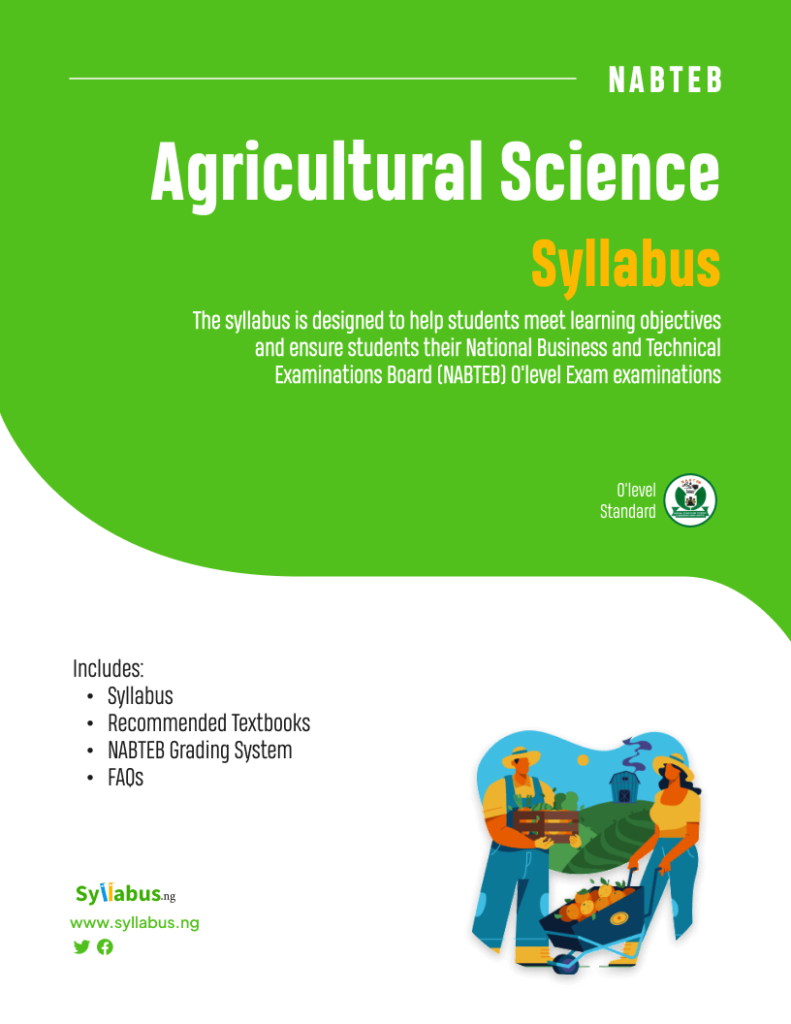NABTEB Agricultural Science Syllabus
High scoring candidates study hard and smart. Knowing what NABTEB wants from you is the first step. Download the NABTEB Agricultural Sciecne syllabus today.

Home » NABTEB Syllabus » NABTEB Agricultural Science Syllabus
Home » NABTEB Syllabus » NABTEB Agricultural Science SyllabusWriting Agricultural Science in NABTEB Exams
This NABTEB Agricultural Science syllabus is an invaluable resource for students preparing for the exam. It outlines the key topics as well as the main areas of focus that will be covered in the exam, such as basic agriculture, animal production, and irrigation. It also provides a list of recommended textbooks and other resources that will help you prepare.
Having this syllabus as your study is a must if you are writing the upcoming NABTEB exams because it will help you prepare even better.
By studying the syllabus carefully, you can rest assured that you are well-prepared for the exam and have a high success rate.
Aims of NABTEB Agricultural Science Syllabus
The aims of the syllabus are to:-
- Impart in the candidates a functional knowledge and practical skills in Agriculture.
- Prepare candidates for further studies in Agriculture.
- Prepare candidates for occupation in Agriculture.
- Stimulate and sustain candidates’ interest in Agriculture.
- Enable the candidates to explore the rich Agricultural resources of Nigeria’s environment.
NABTEB Marking Guide for Agricultural Science
There will be two papers:
paper 1 (Objective and Essay) and paper 2 (Practical), both of which must be taken.
The total mark for both papers is 200 marks.
PAPER I (Objective and Essay)
This paper will consist of two sections; A and B.
Section A will contain fifty (50) multiple-choice questions to be attempted in 50 minutes.
The marks allocated for this section is 50 marks
Section B will consist of SEVEN (7) Essay questions and candidates are expected to answer five questions in 1 hour 40 minutes.
The total mark for this section is 90 marks.
PAPER II (Test of Practical)
This shall be a 2-hour practical test, either the actual practical or an alternative to practical.
It will consist of four (4) compulsory questions, for a total of 60 marks.
NOTE: The actual practical shall be taken by schools during May/June Examinations WHILE the alternative to practical shall be taken by private candidates during Nov/Dec Examinations.
Download NABTEB Agricultural Science Syllabus

Best candidates excel because they study smart and hard. Know what’s expected of you.
Download the NABTEB recommended Agricultural Science Syllabus
NABTEB Syllabus for Agricultural Science Exam
| NABTEB AGRIC SCIENCE SYLLABUS | ||
| SN | TOPICS | OBJECTIVES |
| A: BASIC CONCEPTS | ||
| 1 | MEANING & IMPORTANCE OF AGRICULTURE | i. Define agriculture ii. Identify the different branches/areas of agriculture |
| 2 | PROBLEMS OF AGRICULTURAL DEVELOPMENT & POSSIBLE SOLUTIONS | i. Identify and discuss problems of agriculture development in Nigeria |
| 3 | MEANING & DIFFERENCE BETWEEN SUBSISTENCE & COMMERCIAL AGRICULTURE | i. Students should explain the meaning of subsistence and commercial agriculture |
| 4 | ROLES OF GOVERNMENT IN DEVELOPMENT | i. State roles of government in the provision of: a) Agricultural Finance b) Agricultural education |
| 5 | ROLES OF NON-GOVERNMENTAL ORGANIZATIONS IN AGRICULTURAL DEVELOPMENT | i. Explain the meaning and importance of NGOs |
| 6 | AGRICULTURAL LAWS & REFORMS | i. List land tenure system ii. Explain a) Inheritance b) Individual |
| B: AGRICULTURAL ECOLOGY | ||
| 7 | MEANING & INFORMATION OF AGRICULTURAL ECOLOGY | i. Define agricultural ecology and ecosystem ii. Explain some basic concepts in ecology |
| 8 | LAND & IT’S USES | i. Students should be able to state a) Meaning of land b) Characteristics of land |
| 9 | FACTORS AFFECTING LAND AVAILABILITY FOR AGRICULTURAL PURPOSES | i. Identify factors affecting land availability for agricultural purposes. |
| 10 | AGRO-ALLIED INDUSTRIES AND RELATIONSHIP BETWEEN AGRICULTURE AND INDUSTRY | i. List the agro-based industries ii. State raw materials in each industry |
| 11 | ENVIRONMENTAL FACTORS AFFECTING CROP & ANIMAL PRODUCTION AND DISTRIBUTION | i. State and explain climatic factors affecting crop and animal distribution and production |
| 12 | ROCK FORMATION | i. Students should be able to a. Define rock b. Identify types of rocks |
| 13 | SOIL FORMATION AND PROFILE DEVELOPMENT | i. Define soil ii. List factors of soil formation |
| 14 | TYPES, COMPOSITION AND PROPERTIES | i. Students should be able to recognize the different types of soil ii. Define soil pH iii. Determine the pH of different soil types iv. State ways of correcting soil acidity |
| 15 | PLANT NUTRIENTS AND NUTRIENT CYCLE | i. Students should be able to distinguish between macro and micronutrients ii. List the macronutrients iii. State the functions of each macronutrient iv. State their deficiency symptoms |
| 16 | IRRIGATION | i. Define irrigation ii. Describe underground irrigation |
| 17 | DRAINAGE | i. Students should be able to a) Define drainage b) State the importance of drainage |
| 18 | AGRICULTURAL POLLUTION | i. Students should be able to a. Define pollution b. State the causes of agricultural land pollution |
| C: AGRICULTURAL ENGINEERING MECHANISM | ||
| 19 | SIMPLE FARMS TOOLS | i. Describe simple farm tools |
| 20 | FARM MACHINERY AND IMPLEMENTS | i. Identify types of farm machinery ii. State the uses of farm machine |
| 21 | MAINTENANCE PRACTICES AND PRE-CAUTIONARY MEASURES | i. Explain the meaning of tractor/coupled ii. List the parts and functions of a plow, harrow, and ridges |
| 22 | AGRICULTURAL MECHANIZATION | i. List the disadvantages of agricultural mechanization |
| 23 | PROSPECTS OF AGRICULTURAL MECHANISM | i. Possible ways of improving agricultural mechanization such as developing less expensive machines and establishing agricultural engineering schools for personnel and fabricating simple machines, etc. |
| 24 | FARM POWER | i. Define farm power ii. Explain and state the advantages of human power |
| 25 | FARM SURVEYING | i. Define farm surveying ii. Survey Equipment |
| D: CROP PRODUCTION | ||
| 26 | CLASSIFICATION OF CROPS | |
| 27 | HUSBANDRY OF SELECTED CROPS | i. Student should be able to describe the production of the selected crops e.g. cereal, groundnut, etc, under the following headings – Origin – Local and common name – Varieties/types – Climates/soil requirements |
| 28 | PASTURE AND FORAGE CROPS | i. Explain the meaning of pasture and forage crops ii. State uses of forage crops iii. List types of pasture and characteristics of each type iv. Identify the main pasture |
| 29 | CROP IMPROVEMENT | Students should be able to; i. Enumerate the aims of crop improvement ii. Explain the methods of crop improvement iii. State the Mendel’s law |
| E: FORESTRY | ||
| 30 | FOREST MANAGEMENT | Students should be able to; i. Define the meaning of forest and forestry ii. State the importance of the forest and forestry iii. State forest regulations in Nigeria iv. State and discuss forest management practices in Nigeria |
| F: ORNAMENTAL PLANTS | ||
| 31 | MEANING & IMPORTANCE OF ORNAMENTAL PLANTS | i. Explain the meaning of ornamental plants ii. Identify local ornamental plants |
| 32 | COMMON TYPES OF ORNAMENTAL PLANTS | i. Mention ornamental plants used for different purposes ii. Identify ornamental plants belonging to each category |
| 33 | SETTINGS & LOCATION FOR PLANTING ORNAMENTAL PLANTS | Students should be able to; i. Identify locations or settings requiring ornamental plants ii. Determines ornamental plants for each location. |
| 34 | METHODS OF CULTIVATION OF ORNAMENTAL PLANTS & The IMPORTANCE OF | i. Mention methods of propagating |
| G: CROP PRODUCTION | ||
| 35 | DISEASES OF CROPS | Students should be able to; i. State the meaning of the disease ii. List the effects of disease on crop production iii. Name the important diseases of major crops iv. State the causal organism of each disease v. State the preventive and control measures |
| 36 | PEST OF CROPS | Students should be able to; i. Classify pests into insects and non-insects pests ii. Classify insect pests based on their mode of mouth part iii. Discuss the important insect pests of major crops iv. Recognize and name the important storage insect pests of farm produce v. State the meaning of pests |
| 37 | WEEDS | Students should be able to; i. Define weeds ii. List various types of weeds with their botanical names iii. List the various features of weeds |
| H: ANIMAL PRODUCTION | ||
| 38 | TYPES & CLASSIFICATION OF FARM ANIMALS | i. List the different types of farm animals |
| 39 | ANATOMY & PHYSIOLOGY OF FARM ANIMALS | i. Draw and label parts of a farm animals ii. Dissect a farm animal iii. Sketch these mention their farm parts function |
| 40 | ANIMAL REPRODUCTION | Students should be able to; i. Explain the role of sex hormones in reproduction ii. Describe the process of egg formation iii. Explain the process of reproduction in mammals and poultry iv. Draw and label the parts of the male and female reproductive systems. |
| 41 | ENVIRONMENTAL PHYSIOLOGY | Students should be able to; i. Explain the meaning of environmental physiology ii. State the effects of climate change |
| 42 | LIVESTOCK MANAGEMENT | Students should be able to; i. State the meaning of livestock management ii. State the requirement for good livestock management iii. Explain the importance of these management practices to livestock |
| 43 | ANIMAL NUTRITION | Students should be able to: i. Classify feeds ii. Mention sources and functions of food nutrients iii. State the different types of rations/diet and their uses iv. State causes and symptoms of malnutrition and their corrections in farm animals |
| 44 | RANGELAND & PASTURE | Students should be able to; i. State the meaning of range land ii. List the importance of range land iii. State the characteristics of the range of land iv. Mention some common grasses of livestock range land v. State factors affecting the level of production of herbage |
| 45 | ANIMAL IMPROVEMENT | Students should be able to; i. Explain the meaning of animal improvement ii. State the aims of animal improvement iii. Describe the various methods of animal improvement iv. State the effects of each method and process on animal improvement. |
| 46 | ANIMAL HEALTH MANAGEMENT | Students should be able to; i. Define diseases ii. State the causal organisms of animal diseases iii. Identify some ecto and endo-parasites of livestock iv. Name some important diseases of livestock and their casual organism |
| 47 | AQUACULTURE | Students should be able to; i. Define aquaculture and name different types of aquaculture. ii. Explain the meaning of fish farming iii. State the importance of farming iv. State the conditions necessary for sitting in a fish pond v. Establish and maintain a fishpond vi. Identify different fishing tools and their uses. |
| 48 | APICULTURE OR BEE KEEPING | Students should be able to; i. State the meaning of agriculture ii. List different types of bees iii. State the importance of beekeeping iv. Prepare equipment for beekeeping and produce quality honey v. State various methods of beekeeping and their |
| I: AGRICULTURAL ECONOMICS AND EXTENSION | ||
| 49 | BASIC ECONOMIC PRINCIPLES | Students should be able to; i. List the basic economic principles ii. Discuss the basic economic principles |
| 50 | FACTORS OF PRODUCTION | i. Define factors of production ii. Mention examples of factors of production iii. Discuss each factor of production |
| 51 | PRINCIPLES OF DEMAND | i. State the meaning of demand ii. State the law of demand iii. List the factors that affect the demand for agricultural goods and services. |
| 52 | PRINCIPLES OF SUPPLY | i. State the law of supply ii. List the factors that affect supply; movements along the supply curve and the shift variables |
| 53 | IMPLICATIONS OF DEMAND & SUPPLY FOR AGRICULTURAL PRODUCTION | i. To discuss the meaning of price support ii. Explain the meaning of price stabilization and control |
| 54 | FUNCTIONS OF A FARM MANAGER | i. Explain the meaning of farm manager ii. State the functions of a farm manager |
| 55 | PROBLEMS FACED BY FARM MANAGERS | i. State the problems that farm managers face in the production process |
| 56 | AGRICULTURAL FINANCE | Students should be able to; i. Define agricultural finance ii. State and discuss the importance of agricultural finance iii. Determine and discuss sources of farm financing iv. Mention types of credit based on periods and sources of credit v. Mention problems faced by farmers in procuring agricultural credit vi. State the meaning of agric-business vii. State the source of funds for the capital market |
| 57 | FARM RECORDS & ACCOUNT | i. State the importance of farm records and account ii. State types of farm records. iii. Develop a farm record. |
| 58 | MARKETING OF AGRICULTURAL PRODUCE | i. State the meaning and importance of agricultural marketing ii. List the various marketing agents/channels iii. State the advantages and disadvantages of the various channels iv. List the functions performed by marketing agents v. Importance of exports to agricultural development |
| 59 | AGRICULTURAL INSURANCE | Students should be able to; i. Define agricultural insurance ii. Name types of insurance that can be taken by agricultural operators |
| 60 | AGRICULTURAL EXTENSION | i. State the meaning and importance of agricultural extension. ii. List agricultural extension programs in Nigeria. iii. State some methods of disseminating information to farmers. iv. State some methods of disseminating information to farmers. v. List problems faced by agricultural extension agents in Nigeria. |
Recommended NABTEB Agricultural Science Textbooks
- Essential Agricultural Science for Senior Secondary School by O.A. IWENA.
- Agricultural Science for Senior Secondary School by M.K. KOMOLAFE & D.C. TOY.
- Senior Secondary Agricultural Science by O.A. AKINSANMI
- A textbook of Agricultural Science for School & College by A.C. ANYANWU, B.D.
- Prescribed Agricultural Science for Senior Secondary School.
Frequently Asked Questions About NABTEB Agricultural Science Exam
There is no official pass mark, but scores above 50 are considered good. However, you should try to score as high as you can because the higher you score, the better your chances of admission to your chosen course and institution.
The entire exam takes 3 hours 30 minutes. We would advise you to spend about 3-5 minutes on each question so you can have enough time to go over your work again. Do not spend too much time on questions you do not know.
The NABTEB Agricultural Science exam covers topics like irrigation, land and its uses, drainage, simple farm tools, etc. A full list of topics to study is listed above.
Each section in the exam has its allocated mark and your score will be based on how well you do in every section.
Paper 1 has two sections; the total number of marks for section A is 50 marks and for section B, it is 90 marks.
Paper II is the practical section which will carry 60 marks.
Yes, some schools abroad accept NABTEB results in place of WAEC but it all depends on the school and program you are applying for.
You will be required to answer 50 multiple-choice questions, 5 theory questions, and 4 practical questions based on the syllabus listed above.
Here are a few tips for you; Start studying early enough. Do not do last-minute reading. You should also try practising your time management skills.
Another tip is to study past questions regularly and ensure you get a good night’s rest a day before your exam.
Good luck!
Download NABTEB Agricultural Science Syllabus

Best candidates excel because they study smart and hard. Know what’s expected of you.
Download the NABTEB recommended Agricultural Science Syllabus











